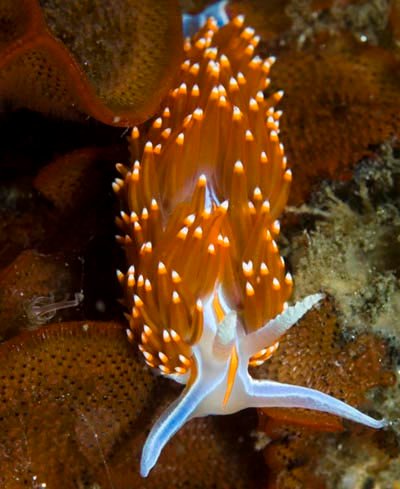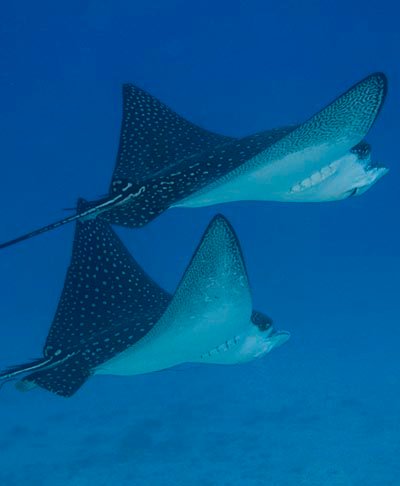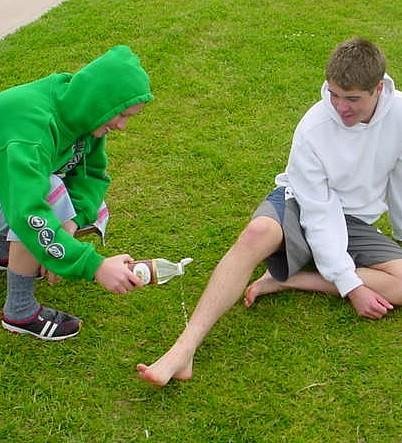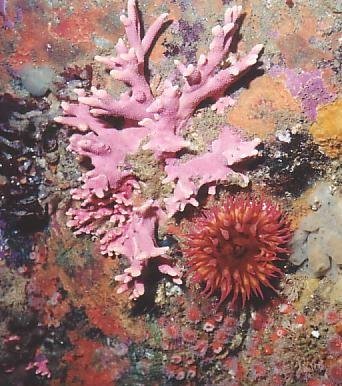Underwater Life
Chances are, you're learning how to scuba dive so you can experience the colorful and unique life that exists underwater. But if you're like most students, some of these creatures are also the source of your biggest fears. During this lesson, you'll learn about the actual threat these animals pose to divers, how to avoid injury, and first aid procedures to follow in the event you are injured.
The aquatic environment is a sensitive one, and divers must treat it with care and respect to preserve it for its inhabitants as well as future divers. This lesson covers the impact divers can have on the environment and steps you can take to help preserve it.

Preventing Injuries From Aquatic Life
People's fears of aquatic life are sparked by grossly exaggerated reports by the media of the danger of aggressive animals in the ocean. While it's true that there are some species that attack innocent swimmers and divers, those incidents are extremely rare. The truth is, most aquatic life injuries are the result of defensive reactions, and not aggressive actions.
You can avoid most injuries from aquatic life by respecting the environment you're exploring. Most potentially harmful animals will only injure you when they are touched, harassed, or provoked. For this reason, you should learn about the harmful life that exists at a site before you dive. This information is available from local dive shops and dive site reference books.

Animals That Bite
Sharks, eels, and other species of fishes are capable of inflicting painful and serious bites. Fortunately, these animals are rarely aggressive, and can be safely observed as long as you do not make them feel threatened.
Encounters with sharks are rare because most flee the area before divers have a chance to observe them. If you are lucky enough to see one while diving, it's important not to make it feel cornered. As long as they are confident that they can leave the area, most sharks are harmless.
Eels are long snake-like fish that spend most of their time hiding inside crevices. They rarely attack divers, and can be safely observed while they are out hunting at night. The most common cause of eel bites is placing your hands inside crevices where they hide during the daytime.


Animals The Sting
Jellyfish and corals have special stinging cells that are triggered on contact to shoot out and penetrate the skin of their prey. The intensity of these stings varies by species, and most are not harmful to humans. However, there are some species that inflict painful and possibly fatal stings to humans. Before you dive a new location, you should research the dangerous corals and jellyfish that are common in the area and avoid direct contact with them while diving.
Stinging cells cannot penetrate wetsuits, dry suits, and most diveskins, so you should wear some form of exposure suit even when it's not needed for thermal protection.

Animals With Spines
Many aquatic animals have sharp spines that can penetrate the skin and inflict painful wounds. The most common of these animals is the sea urchin, which can be found at almost every marine dive site. These are slow moving invertebrates that can cause injury when stepped on or accidentally touched.
Many animals have spines that inject venom. One example is the stingray, which has a venomous spine on its tail. Stingrays are not known to be aggressive, but they injure many swimmers and divers who accidentally step on them. The best prevention against stingray injuries is to shuffle your feet when walking on the sand. This scares rays away from the area before you get close enough to step on one.
Other animals with venomous spines include lionfish, coneshells, and scorpionfish. Like urchins and rays, these animals do not attack, and only cause injury when touched by divers.


Animals That Cut And Scrape
Cuts and scrapes are the most common injuries that result from aquatic life. Animals such as hard corals and barnacles can be very sharp and easily cut divers when stepped on or scraped against.
Most of these injuries occur during entry and exit. For example, when shore diving, you may have to walk through shallow water where barnacles or broken pieces of coral are prevalent. Ascending and descending along a mooring buoy line can also be hazardous, as these lines often become home to sharp barnacles.
The best prevention against cuts and scrapes is to avoid contact with sharp animals. For skin protection, you should wear an exposure suit complete with booties and gloves. But be aware, you're more likely to touch corals when wearing gloves, so they are prohibited in many areas.

Treating Aquatic Life Injuries
How you treat an aquatic life injury depends on the type of injury you receive. For example, bites should be treated with an antiseptic, bandaged, and if severe, treated by a physician.
To treat stings from jellyfish and corals, scrape the stinging cells off the skin with a piece of plastic (such as your c-card) and apply a neutralizing agent such as vinegar or ammonia to the affected area. If the pain is severe, or allergic reactions develop, seek medical attention.
Treatment for puncture wounds from urchins, stingrays, and spiny fish includes removing any remnants of the barb from the skin and soaking the wound in water as hot as the victim can tolerate for 20 minutes. Seek medical attention for any venomous wound, as many can be serious.

Negative Impacts of Diving
It's an unfortunate fact that many of the most beautiful dive sites in the world have been severely damaged by the large number of divers who visit those locations. Most of the damage is unintentional, but also avoidable. As a diver, you must do your part to protect the environment so others can enjoy it in the future.
Dive sites are easily damaged as a result of poor buoyancy control, abuse of marine life, irresponsible hunting and collecting, and pollution. The pages that follow describe how these actions harm a dive site, as well as steps you can take to prevent this damage from occurring.
Effects of Poor Buoyancy Control
Proper buoyancy control is important not only for your own safety and enjoyment, but the protection of the environment as well. By maintaining neutral buoyancy during your dives, you'll avoid contact with fragile bottom dwellers and delicate growths of coral.
Poor buoyancy control also increases the amount of sand that your fins kick up into the water. When these sand particles settle, they can smother filter feeders and tiny organisms such as coral polyps.
Abuse to Aquatic Life
The aquatic environment is full of invertebrates that are either solitary or slow moving. This makes them particularly vulnerable to divers who touch or handle them.
Many of these organisms are extremely delicate, and even the slightest touch can bruise their external body or internal organs. Additionally, many species have thin protective coatings that are removed when handled. Even if you handle an organism carefully, the oils on your skin can have adverse effects on its health.

Hunting & Collecting
Two activities that draw many to the sport of diving are hunting and shell collecting. Obviously, these activities can be detrimental to the environment if conducted irresponsibly. But with the right approach, you can take home a fresh dinner or memorable shell collection while having minimal impact on the environment.
Responsible spearfishers are conservational in nature. They only shoot what they eat, and avoid taking threatened species or undersized fish. Before spearfishing, check the local fish and game rules and familiarize yourself with the legal species and their daily limits. Avoid taking species that are low in numbers.
When collecting shells, never take a shell that contains a living organism. Chances are, where there are live species of shellfish, you'll also find vacant shells from the same species.

Trash & Pollution
As divers, we must take special care to avoid polluting the environment we dive in. The most common form of pollution is trash, which can be blown into the water when not safely discarded on the shore or boat.
Trash can cause serious injury or death to many animals. For example, six-pack rings can trap birds, fish, and other animals. Before discarding six-pack rings, you should cut the rings open to prevent injury to animals in the event it accidentally ends up in the water.
Plastic bags are another type of trash that injures marine life. When in the water, plastic bags have the appearance of jellyfish. When predators of jellyfish see these bags, they unfortunately attempt to consume it. This causes fatal injuries to many species, especially sea turtles.

Positive Impacts of Diving
As divers, we have a unique opportunity to help conserve an environment that most have no access to. For example, only divers have the ability to remove trash from the sea floor. You can help by picking up trash during your dives, or participating in sponsored underwater clean-up activities that are held in many areas.
Sharing your discoveries and experiences with others is another way to help conserve the environment. For example, if you're at a shore and notice some curious tourists looking into the water trying to figure out what they see, or are simply interested enough to watch, offer to answer any questions they may have. Odds are they are full of questions, and will be fascinated to learn what's below the surface. And that can motivate them to conserve, and maybe even share with others.
Site Conditions